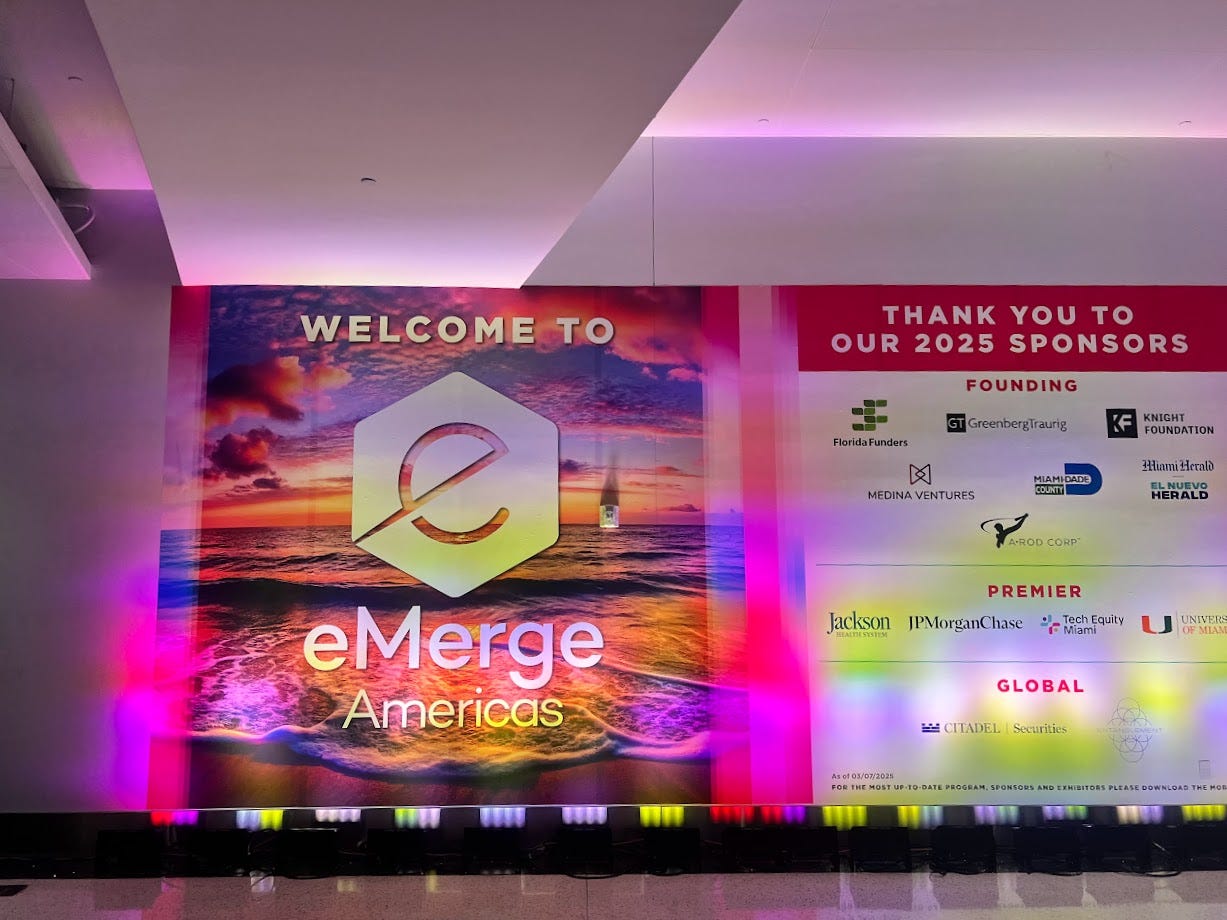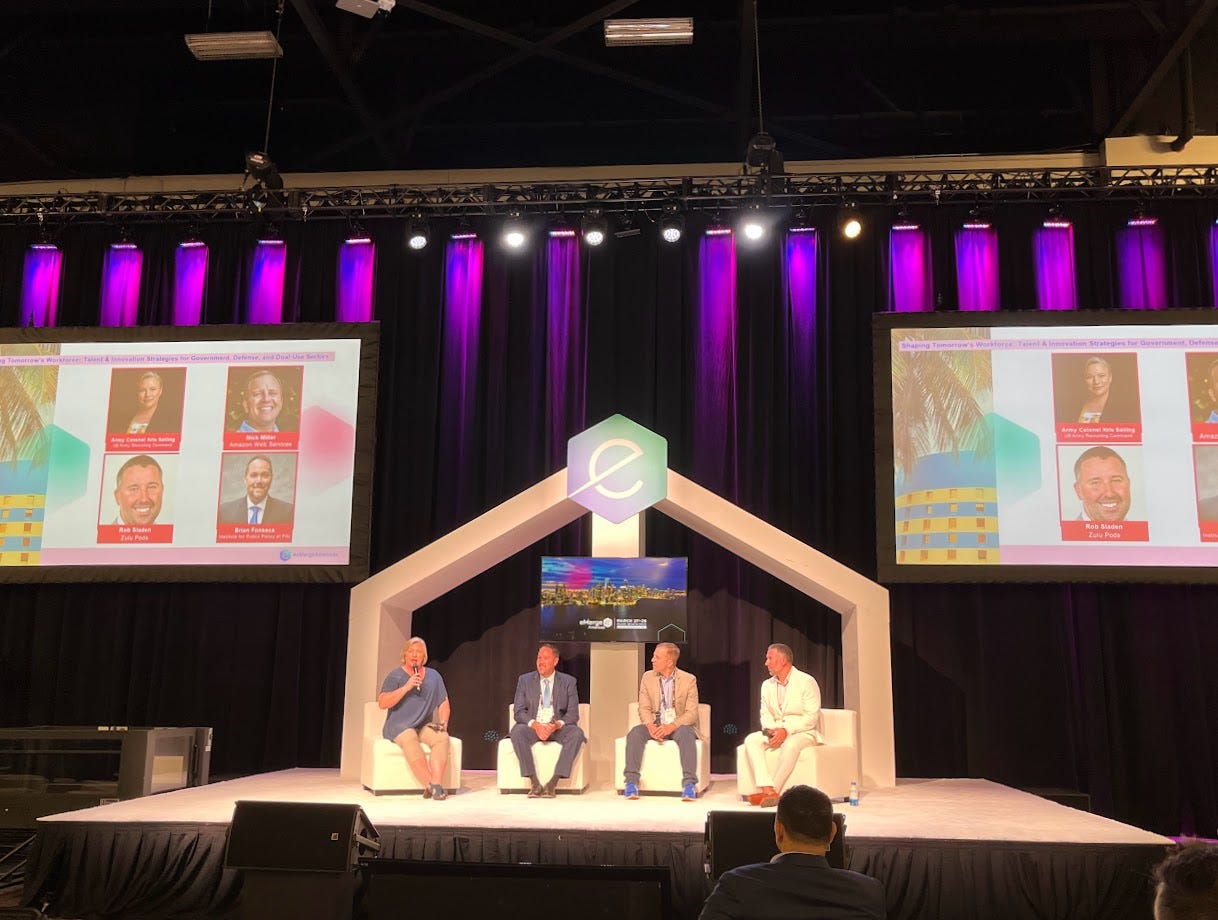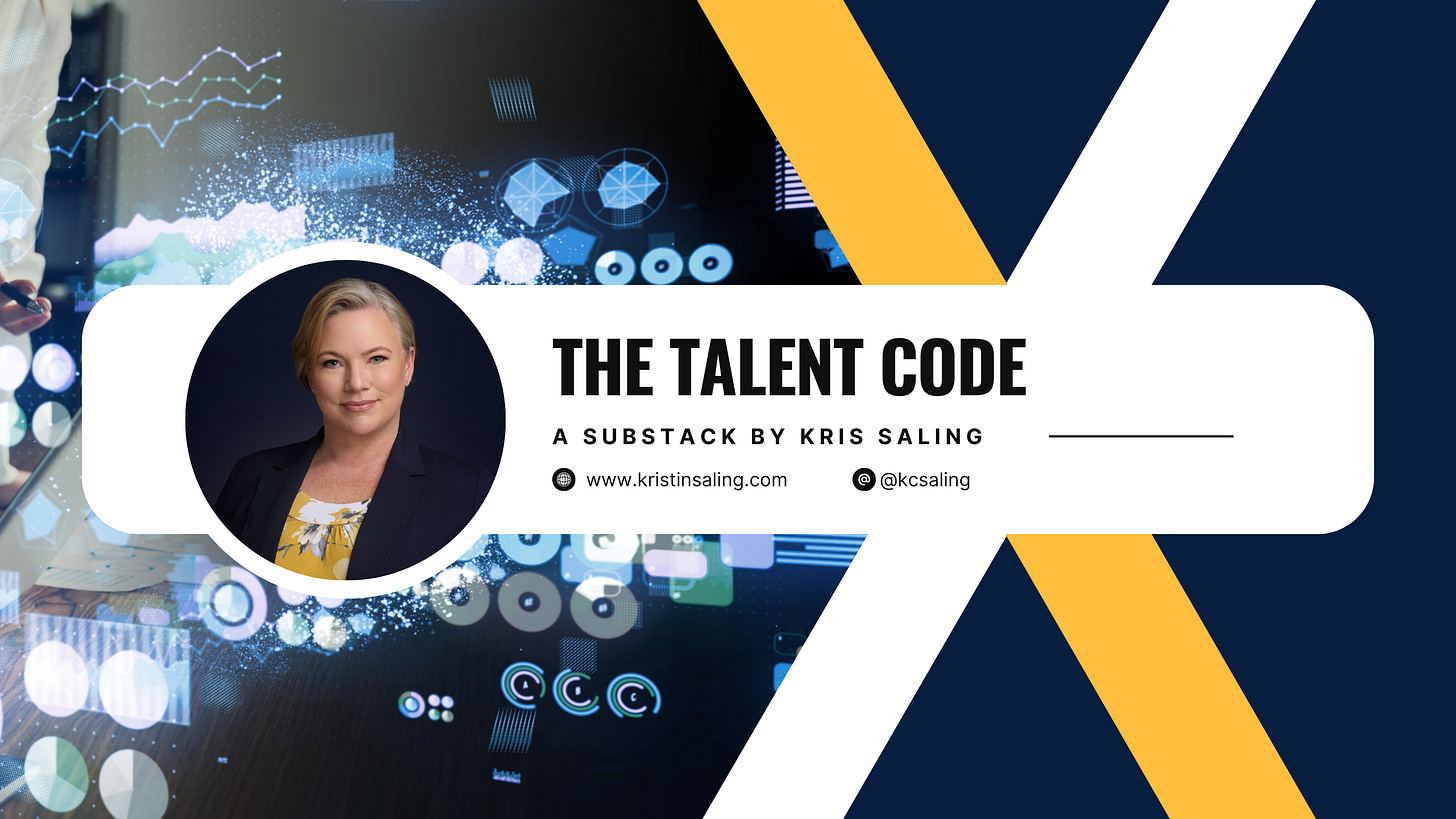Human Skills are the Hard Skills
Judgment, Leadership, and Empathy matter more than ever in an AI-driven world
From Miami to Manhattan, the future of talent is everywhere - and lately, so are my flight plans! Last week, I had the incredible privilege of hosting a talent innovation panel at eMerge Americas in Miami, surrounded by some of the sharpest minds in industry, academia, and public service.
It was an energizing experience—Army Futures Command showed up in force, and the conversations around shaping the future government workforce were bold, forward-looking, and refreshingly candid. From catching up with longtime collaborators to making new connections, it reminded me just how powerful our community is when we bring the right people together at events like this.
And we're not slowing down. This week, I’m heading to BetterUp Uplift in Manhattan, where I’ll be co-hosting a government roundtable and reception with the brilliant future of work thought leader Mika Cross, BetterUp COO and co-founder Eddie Medina, NSF assistant IG Javier Inclán, legendary Director of the Positive Psychology Center at the University of Pennsylvania Dr. Martin E.P. Seligman, and AI and government workplace transformation specialist Sarah C. Moffat!
If you’re focused on building purpose-driven, resilient, and high-performing teams in government or beyond, you won’t want to miss what’s happening in that room!
All of the conversations we’ve had and will have at these events lead me right into this week’s deep dive: Human skills are the hard skills. After focusing on tech frameworks for a couple weeks here, I want to reemphasize the core of what truly drives organizations forward: people.
Let’s decode it. 🚀
Human Skills Are the Hard Skills
This concept turned up several times, not just in our talent innovation panel, but throughout the eMerge Americas conference. You could buy all the tech in the world, but if you didn’t invest in the right workforce, in the right people, you weren’t transforming.
At eMerge Americas last week, I had the privilege of hosting a panel with leaders across industry, government, and academia, and we kept returning to this thought:
The more we integrate technology into our workflows, the more we need to double down on distinctly human skills.
We often call them "soft skills"—empathy, communication, adaptability, leadership, judgment—but let’s be clear.
These are not soft skills. These are power skills. And they’re only becoming more valuable.
In an age where AI can summarize a report, generate code, and even draft policy memos, it’s the uniquely human capabilities that differentiate not just individuals, but entire organizations. Let’s explore what that means in practice, and how we can assess, develop, and reward human skills in a high-tech environment.
What AI Can’t (Yet) Replace
Let’s be honest. AI can (and should) replace a lot. It can process enormous data sets, surface patterns we miss, write at speed, and even detect emotional tone in text. My newsletter last week provides a pretty good framework for figuring out what it should eliminate and what it should elevate. But it’s still fundamentally reactive, not reflective.
It doesn’t have values. It doesn’t build trust. It doesn’t lead people through change. And it really doesn’t inspire, not the way we’re used to.
Those things are still human capabilities, and while AI will keep improving, the things it can’t replace (at least not anytime soon) include:
Empathy: Not just identifying but understanding what others feel and need
Judgment: Making the call when data is incomplete or ambiguous outside of rules
Leadership: Motivating people to align, grow, and act
Communication: Translating complexity into shared understanding
Adaptability: Remaining grounded and effective through uncertainty
These aren’t “nice to have” skills. They’re mission-critical, especially when AI is in the mix. Let’s face it: as AI gets better at “doing,” humans need to get better at “being.”
Why Human Skills Are Harder Than Ever
Ironically, the more we emphasize digital fluency and AI literacy, the harder it becomes to develop human-centric skills at scale.
Why?
They’re less visible: You can track click-through rates. You can’t track empathy.
They’re harder to measure: Most organizations don’t have a competency model for trust or adaptability.
They’re undervalued in performance systems: Promotions often go to technical experts, not the best communicators or collaborators.
They take time and context to develop: You don’t become an empathetic leader after a workshop. You grow into it through experience, feedback, and reflection.
But we need to change that—fast. Because the organizations that will thrive in this era of AI-infused transformation aren’t the ones with the best tech stacks.
They’re the ones with the strongest human stack.
So How Do We Assess These Skills?
You can’t measure empathy the way you measure output, but you can build systems that prioritize and reward human capabilities.
Here’s how some organizations I’ve worked with are starting to rethink assessment:
🔹 Behavioral interviews with emotional intelligence focus – Asking not just “what did you do?” but “how did you navigate the people side?”
🔹 360 feedback and peer reviews – Incorporating perspectives beyond just the manager to surface patterns in communication and trust.
🔹 Situational judgment assessments – Using scenarios that test decision-making in ambiguity, tension, or high-stakes environments.
🔹 AI-powered sentiment analysis – Even where AI isn’t replacing functions, remember that it can be a big help! Natural language processing tools can detect tone, empathy, and conflict patterns in written communications, especially when partnered with human interpretation.
But the key is this:
If you want to signal that human skills matter, you have to measure what matters.
And that means building human-centered competencies into hiring, promotion, and leadership development models.
Developing Human Skills in a Digital World
You don’t teach adaptability with a slide deck. You develop it through experience, vulnerability, and stretch. Here are some ways to bake development into the culture:
🔹 Create forums for truly open discussion – Environments where people can share ideas, fail, and learn out loud build emotional intelligence and trust.
🔹 Embed reflection into learning – Whether in after-action reviews or coaching sessions, asking people to pause and process builds better judgment.
🔹 Use coaching, not just training – Formal learning is useful, but coaching helps develop human skills in real time, grounded in actual challenges.
🔹 Celebrate relational wins – Highlight success stories where communication, collaboration, or care made a difference—not just deliverables.
If we only reward output, we only develop efficiency. If we want human skills to grow, we have to recognize and reinforce them as part of performance.
What the Best Teams Are Doing
Some of the most effective teams I’ve seen, whether in the Army, discussing and collaborating at eMerge and other events, or within partner companies, are actively creating cultures that elevate human skills.
They:
✅ Make the freedom of ideas and communication non-negotiable
✅ Hire and promote for curiosity, drive, teamwork, mentorship, and leadership - not just credentials
✅ Train leaders to be coaches, not just taskmasters
✅ Build environments where challenging assumptions and differing perspectives are not only welcomed but expected
✅ Use AI to free up time for more human connection, not replace it
At eMerge, we talked about the power of intentional culture and the need to develop talent not just for functional roles, but for mission-driven leadership in complex, shifting environments. That’s not just a nice-to-have. It’s a national security imperative.
Build the Human Stack
Sure, your tech stack matters. But your human stack will define your future.
No amount of AI will solve a leadership vacuum. No chatbot will build trust in a crisis. No algorithm will coach your high-potential employee into their next role.
That’s the work of people. Of empathy. Of judgment. Of real leadership.
So as we continue to integrate new tools into how we work, let’s also invest in the harder, more meaningful side of talent: the human side.
Because in the end, that’s what makes transformation not just possible, but sustainable. 🚀
Talent Trends & Insights
Here’s what I’m paying attention to this week - or yeah, my 5 things.
1. Continued Civil Workforce Reduction in DoD.
Secretary Hegseth signed a memorandum directing the realignment of the DoD's civilian workforce to improve efficiency and incentivize top performers. This continues to drive cuts on “duplicative efforts and “excessive” bureaucracy, and reopens the deferred resignation program (DRP), offering DoD civilian employees the opportunity to resign with full pay and benefits.
This largely looks at positions eligible for Voluntary Early Retirement Authority (VERA) and Voluntary Separation Incentive Payment (VSIP). VERA allows eligible folks to retire early with immediate annuity benefits, and VSIP is effectively a buy-out, primarily in positions the agency wants to downsize or eliminate. Figuring out what positions those are in this environment is just one of many complications.
This at least is the first time I’ve seen this transformation embrace automation. If we’re going to reduce the size of our workforce, there are things we absolutely have to automate. Decision makers are going to have to accept that this will come with a cost, and true cost savings won’t appear until we get the automation up and running.
2. Review of Military Standards.
Defense Secretary Pete Hegseth has mandated a review of the military's combat and physical fitness standards, advocating for uniform requirements irrespective of gender. This directive has sparked debate, with concerns that abrupt changes could negatively impact recruitment and retention. The review will also reassess appearance policies and consider the implications of enforcing gender-neutral standards across all service branches.
I’ve been in the Army for more than a day, and while a review of standards always comes with a lack of mission/OPTEMPO, I personally don’t see anything wrong with pushing for high standards. However, and this is a big however, organizational culture has to allow for it. For example, an organization that prizes “butts in seats” where people get lectured for going to the gym during duty hours instead of sitting at a desk, sitting in a conference room, or sitting in their preferred mode of commute, is not going to have fit people. If it’s a person’s duty to be fit, give them duty time to be fit.
3. Data Driven HR Monthly by David Green.
If you are interested in all things data, HR, and people analytics and you aren’t already subscribed to author, speaker, and people analytics leader David Green’s updates, I highly recommend it. He’s got the rollup of what’s happening in the people analytics sphere from conferences and meet-ups, the global state of workforce strategies and workforce transformation, and tons of curated resources!
Several of this month’s articles highlight skills-based strategies and how to incorporate AI into these strategies to continue scaling at speed, which I’m especially paying attention to right now.
4. The Weekly Show with Jon Stewart.
Okay, it’s political. I like listening to political commentary even if I studiously avoid making it. Still, skip to 1:11:34 - The measure of government is the people it helps.
Or it should be. It isn’t. Sometimes I feel like it’s the number of people we have somehow wedged into the R quadrant of the RACI chart rather than let them simply exist in the I (RACI = Responsible, Accountable, Coordinating, Informed). We have so many people built into the decision-making process that it creates a massive barrier to actually getting things done.
My last boss at ASA(M&RA) absolutely hated the need to fight for what she called a false consensus to get anything done. Why did we have to litigate every little detail of something until everyone agreed when people were, again referring to RACI, in the inform category and not responsible or accountable for the decision?
A lot of federal controls were put into place with good intentions, but instead of protecting the public interest, they drive up cost, water down goals, and stifle innovation. If we’re going to improve how the government spends money, we need to focus on smarter, not just stricter, oversight.
5. Where are the writers…and where are the readers?
Andrew Steadman and Teddy Kleisner talk about some key points on the Army’s effort to reinvigorate writing programs. Where are the leaders who have written things that inspire the writers they want to start professional dialogue? And where are the important readers - the future writers being inspired or the senior leaders who can act on a critical thought?
One of the biggest questions I have for all the writing fellowships out there is…how many people able to act on the things being written about are reading those publications, and how many articles translate into action? I’ve activated a couple of programs I read about, but I honestly want to know how often that happens. I want it to be the norm rather than an outlier.
A comment on this article says, “In my personal experience, senior leaders focused more on the next major PT event than on a collective deep-thinking project. While PT is important, it doesn’t foster a focus on the profession of arms to build future leaders capable of shaping the organization.” That calls back to Gen. (R) James Mattis and one of his many pithy quotes: “The most important six inches on the battlefield are those between your ears.” We need to exercise both for success.
Final Thought: Keep on going
It’s like the Rodney Atkins song—if you’re going through hell, keep on going, whether you’re wrestling with cumbersome bureaucracy or trying to outpace the disruptors among us. The work you’re doing as an innovator lays the foundation for lasting and meaningful transformation. Stay focused on the core strengths that drive real change, and remember that it’s not the tech that will win the day. It’s the people.




